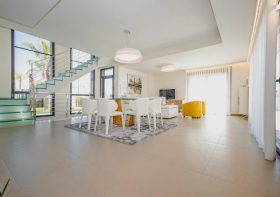Virtual Reality Tech may soon make “going shopping” in real life obsolete

Online high-street shops have become commonplace and offer new ways to interact with customers. The consumer has become used to using different devices to shop. This is why m-retailing was created. This mix of real and virtual worlds may help to prepare for the “next biggest thing” in shopping: virtual reality shopping.
Virtual reality (VR), also known as virtual immersion, is typically delivered through headgear and goggles. These devices block out the world around the user to immerse them in the virtual environment. It is different from augmented reality, where digital content is overlaid on top of the real world to provide access to both. Google Glass, for example, displays digital information on its visor.
Apps allow you to try on clothes and accessories in augmented reality. Eawentling, CC BY-NC-SA
AR is compatible with mobile devices and has already been built into some apps. However, VR must be comfortable and stylish and run on software that can produce immersive visual effects. You can add a deeper level of engagement by including other senses. For example, tactile controls allow you to manipulate and handle objects.
Tech in-store
Magic mirrors are projections of how you would like to appear. Intel, CC BY-SA
Retailers have been inconsistent in their use of technology. In-store Wi-Fi is more available, and some shops offer tablets and touchscreens for customers to search and browse for items or look up information. Video screens that display fashion collections are more common, and they’re often linked to apps with inspirational looks. More cutting-edge tech is less common, like magic mirrored, which overlays the shopper’s image with the clothes that they have selected and allows them to change style and color options. They can also be less reliable.
Shoppers tend to prefer functional interactions with retailers over playful ones. The additions that are helpful and informative, saving the customer time by helping him locate the product in the store or another location, are welcomed. It is not surprising that consumers prefer engagement over marketing and would rather pay nothing for these services. Snapchat and Instagram are the preferred platforms for young fashion shoppers to share pictures of their potential purchases. The retailer’s backdrop is crucial to the image.
The current trends indicate that interactive window displays will be expanded, as well as in-store communications using a combination of GPS, transmitters like the Apple iBeacon, or other devices that use Bluetooth to communicate with shoppers’ smartphones. They will bring micro-marketing and personalization to a whole new level, with offers and information being sent to shoppers’ smartphones in real-time as they walk past product displays.
Retailers will look to their relationships with their customers more and more in order to support their brands. This will lead them to new opportunities, such as stories, images, and videos – particularly fashion and cosmetic blogs, which have proven very successful. These are not virtual realities but rather augmented reality.
Making a (virtual impression)
What does this mean for virtual reality? As retailers gain confidence in offering content via them, we can expect more trials. The new VR headsets from Oculus and Sony, for example, will provide more immersive and realistic environments. Sony is aiming to enhance the user’s experience by leveraging its PlayStation expertise. Virtual stores have been piloted by some brands, allowing VR-equipped customers to experience the same feeling of browsing racks and shelves looking for something that catches their eye without having to leave home.
VR will allow users to revisit and experience past fashion shows, exhibitions, and events. Top Shop, for example, recently broadcast London Fashion Week as it occurred to customers at its Oxford Street shop through Oculus Rift. This may allow retailers to extend the life of specific promotions for individual customers.
Immersion has the potential to be a great tool for creating or recreating 3D environments. This could help those who are buying furniture, décor, paint, and other home furnishings visualize how their future homes will look. The Virtuix platform, which was recently developed, provides a motion control that converts the user’s physical movements into equivalents within the virtual environment. This allows the user to walk around the virtual world literally.
There’s still a long way to go until VR is the next big thing for shopping. Neither the technology nor the acceptance of VR by shoppers are where they need to be.




Leave a Reply